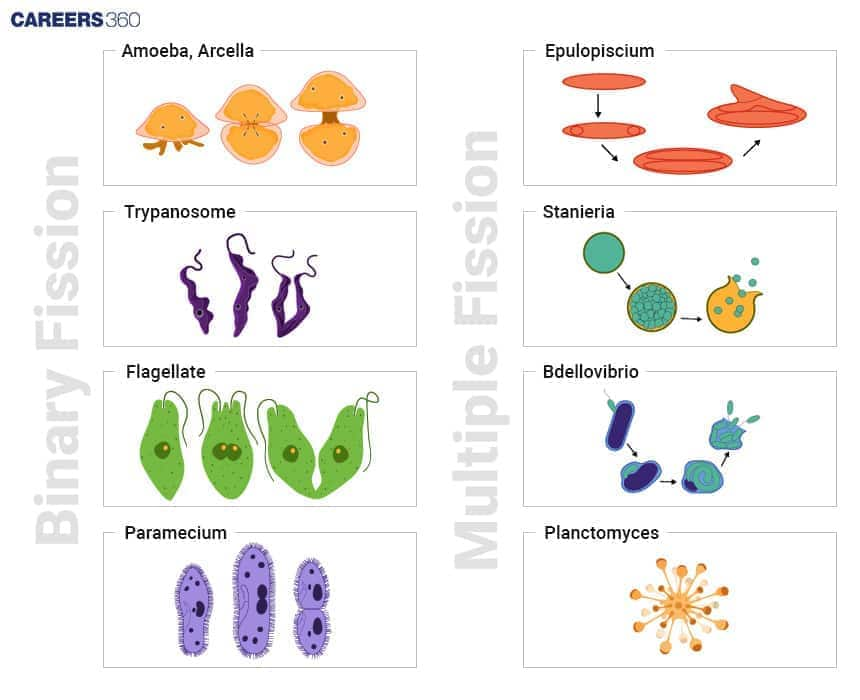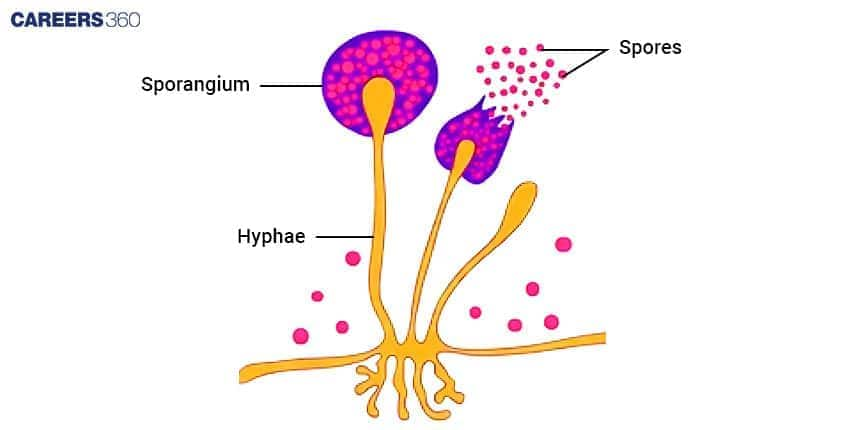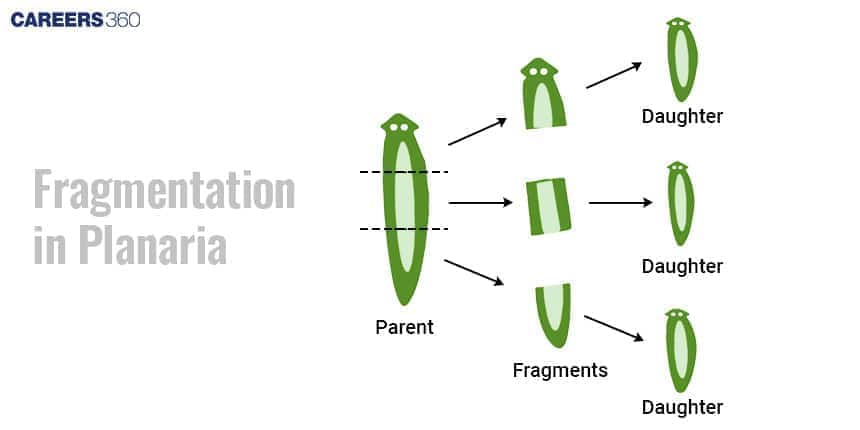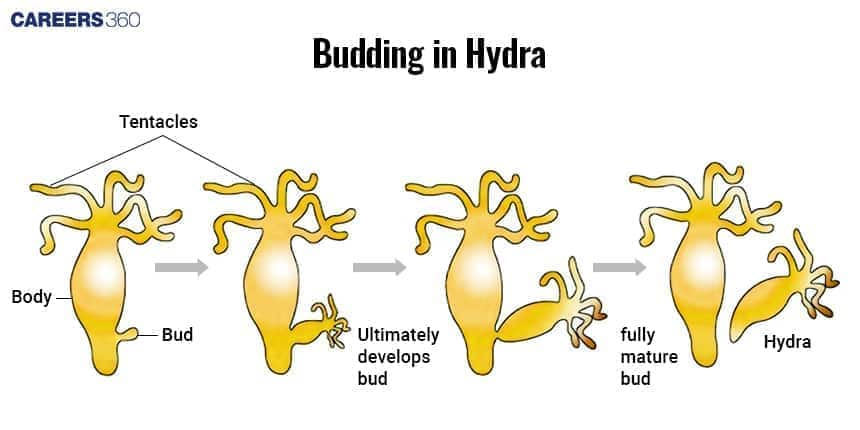Asexual Reproduction - Advantages & Examples
Asexual reproduction is the process where a single parent produces offspring without gamete fusion. The offspring are genetically identical to the parent, known as clones. This mode is common in plants, animals, and microorganisms, making it an important Class 12 biology topic for exams like NEET.
This Story also Contains
- What Is Asexual Reproduction?
- Characteristics Of Asexual Reproduction
- Asexual Reproduction in Plants
- Asexual Reproduction in Animals
- Advantages of Asexual Reproduction
- Disadvantages of Asexual Reproduction
- Examples of Asexual Reproduction
- Difference Between Sexual Reproduction and Asexual Reproduction
- Asexual Reproduction NEET MCQs
- FAQs on Asexual Reproduction
- Recommended Video on Asexual Reproduction
.jpg)
Reproduction refers to the production of offspring from an organism. It is vital in the transfer of genetic material from one generation to another. It is categorised into two types: asexual and sexual. It covers all mechanisms by which living organisms allow genetic material to pass from one generation to another. The importance of reproduction is in the survival and evolution of species. Without the process, species would go extinct because it replaces individuals in the population and ensures the continuity of genes through desirable traits. In asexual reproduction, parents and the offspring are genetically identical. In sexual reproduction, there are two parents, and the offspring produced are genetically diverse.
What Is Asexual Reproduction?
Asexual reproduction is a method of reproduction in which a new offspring is generated from a single parent. This new individual will be genetically and physically identical to each other, hence considered a clone of their parents. There is no fusion of the gametes in the asexual mode of reproduction, and hence, no change in the number of chromosomes occurs. Offspring inherit the same genes as their parents with the rare possibility of genetic mutation.
Only one organism is needed to reproduce, there are no gametes involved in the process.
The offspring is an exact genetic replica of the parent, variation does not exist.
Asexual reproduction is quick, and hence, there is rapid growth in the population.
Characteristics Of Asexual Reproduction
Asexual forms of reproduction are noted to occur not only in unicellular organisms but also in multicellular ones. Some of the other characteristics of asexual reproduction are as follows:
Only one parent is present.
Fertilization and formation of gametes do not take place.
Reproduction is rapid.
Organisms have a higher growth rate.
The offspring produced are identical to each other and the parent.
Asexual Reproduction in Plants
The most common natural method of asexual reproduction in plants is vegetative propagation. In this, new plants are formed from parts of the plants such as roots, stems, and buds. Such plants include jasmine and rose, among others. Vegetative propagation can be induced either naturally or artificially.
Artificial Asexual Reproduction in Plants
Some of the artificial methods of plant reproduction include:
Cutting
In this method, a portion of a plant such as a stem or leaf is cut and placed in soil. Watering the soil, the underground portion of the plant develops into another plant. It is one of the easiest and cheapest means of asexual reproduction.
Grafting
Grafting requires only the grafting of two very different plants. The two plants are tied together with a thread and are then planted in the ground. As time goes by, they grow like one but have traits from both parent plants.
Types of Plants Asexual Reproduction | Explanation |
Runners | Horizontal stems are produced from new plants at the nodes. |
Rhizomes | Underground stems give rise to new shoots and roots. |
Tubers | New plants are grown from swollen underground stems. |
Bulbs | These are new plants that grow from storage organs |
Corms | The new shoots grow through swollen underground stems |
Asexual Reproduction in Animals
Different animals use different asexual methods like binary fission, budding, fragmentation, regeneration, and sporulation to reproduce and survive in their environments. The various modes of asexual reproduction in animals are
1. Binary Fission
Binary fission is a form of asexual reproduction in the organism called an amoeba. The totality of the body undergoes mitosis, which is also referred to as equational division, and splits into two daughter cells. Two steps occur in the process:
Karyokinesis: Nuclear division
Cytokinesis: Cytoplasmic division

2. Sporulation
In sporulation, the nuclear membrane disappears, and blocks of chromatin move into the cytoplasm. These blocklets grow into small nuclei and eventually into spores, which mature under suitable conditions to produce new offspring.

3. Fragmentation
In fragmentation, an organism breaks into fragments, and each piece develops into a whole new individual. Spirogyra, an alga, can regrow from any cut or broken fragment and functions as an independent cell.

4. Budding
In budding, a new organism develops from bud formation on some part of an old one.
In budding, a new organism grows from a small projection or bud on the parent organism. This bud detaches and forms a new individual. This method is common in plants such as potatoes. For example, when potatoes are stored, they grow tiny growths called "eyes." When these are planted, they grow into new potato plants.

5. Regeneration
In regeneration, the parts can develop to form a whole organism, and organisms can regenerate lost parts. The best example is that of planaria. These are flatworms whose body parts may regenerate to form a complete organism with the part that has been lost.
Advantages of Asexual Reproduction
Asexual reproduction is a fast and simple method where only one parent is needed. It helps organisms produce many identical offspring quickly without needing a mate. Some of the advantages are mentioned below:
No need for a mate, so reproduction is easier.
Rapid reproduction leads to an increase in the population within a very short period.
Production of large numbers of offspring in a short period.
Positive genetic traits are passed to next generations.
The process might take place in varied environmental conditions.
Disadvantages of Asexual Reproduction
Asexual reproduction produces offspring with little to no genetic differences. This makes it harder for them to survive changes in the environment or fight diseases. Some of the disadvantages are mentioned below:
The offspring are more susceptible to diseases and changes in the environment with limited genetic diversity.
The ability to adapt to changing environments is challenging and therefore poses a threat to survival.
Biodiversity is limited among organisms due to the participation of only one parent.
A change in one environmental factor can wipe out the entire population of a given organism.
Examples of Asexual Reproduction
Asexual reproduction in organisms is seen across various species, including bacteria, worms, plants, and reptiles. These examples of asexual reproduction show how different organisms multiply without the need for a mate.
Bacteria reproduce using binary fission, wherein the cell divides into two, along with the nucleus.
Blackworms or mudworms reproduce through fragmentation.
Hydras reproduce by budding.
Some reptiles like copperheads can reproduce by parthenogenesis.
Sugarcane can be propagated through vegetative propagation.
Difference Between Sexual Reproduction and Asexual Reproduction
Sexual and asexual reproduction differ mainly in the number of parents involved and the genetic outcome. While sexual reproduction promotes variation, asexual reproduction ensures rapid population growth with identical traits. These differences affect adaptability, evolution, and survival strategies.
Feature | Sexual Reproduction | Asexual Reproduction |
Genetic Variation | High genetic diversity due to the recombination of genes. | Genetic uniformity; offspring are clones of the parent. |
Methods of Reproduction | Internal fertilisation, External fertilisation | Binary fission, Budding, Fragmentation, Vegetative propagation, Spore formation |
Complexity of Processes | Complex involving meiosis, fertilisation, and the developmental stages. | Simple, involving mitosis and direct development. |
Speed and Efficiency | Time-consuming and energy-intensive process. | A quick and efficient process requires less energy. |
Asexual Reproduction NEET MCQs
Q1. Hydra reproduces asexually by
Budding
Binary fission
Multiple fusion
Vegetative propagation
Correct answer: 1) Budding
Explanation:
A little bud or protrusion develops on the parent Hydra's body during this phase. The new person who emerges from this bud is genetically identical to the parent. The bud separates from the parent and becomes an independent creature after it has reached full development.
Budding is a type of asexual reproduction, which means that gametes (egg and sperm) do not fuse. Rather, a single creature can create children by itself.
Hence, the correct answer is option 1) Budding.
Q2. ‘Clones’ are individuals that have exactly the same
Lifespan
Physiology
Growth rate
Genetic makeup
Correct answer: 4) Genetic makeup
Explanation:
Clones are the offspring that are produced as a result of asexual reproduction and are not only identical to one another but are also exact copies of their parents.
- wherein, the term clone is used to describe such morphologically and genetically similar individuals.
Hence, the correct answer is option 4) Genetic makeup.
Q3. Asexual reproduction by zoospores is observed in
Penicillium
Hydra
Sponge
Chlamydomonas
Correct answer: 4) Chlamydomonas
Explanation:
The Chlamydomonas is a green alga that spends most of its life cycle in a haploid vegetative phase and produces daughter cells asexually by mitosis.
In unfavorable conditions, the sexual phase is triggered and some of the vegetative cells develop and form isogametes. Then fusion of these isogametes forms a diploid-resistant zygote for adaptation to survive in harsh conditions.
When the conditions become favourable again, meiosis of zygotes occurs and the two-plus (mating type) and two minuses (mating types) are produced. When mitosis of Zoospore occurs, it makes the cell return to the vegetative colonies.
Hence, the correct answer is option 4) Chlamydomonas.
Read More:
FAQs on Asexual Reproduction
Define asexual reproduction.
Asexual reproduction is a type of reproduction where a single parent organism produces offspring that are genetically identical to the parent. This process does not involve the fusion of gametes or the exchange of genetic material between two individuals. The offspring are genetically identical to the parent, hence called clones. It commonly occurs in unicellular organisms like bacteria, Amoeba, and yeast, as well as in simple multicellular organisms such as Hydra and certain plants. This method ensures rapid increase in population.
What are the characteristics of asexual reproduction?
Asexual reproduction involves only one parent, and gametes are not formed. The process is usually simple, rapid, and energy-efficient. Offspring produced are morphologically and genetically identical to the parent with no variation. It commonly occurs in unicellular and simple multicellular organisms, such as protists, fungi, algae, some plants and animals.
What are the advantages and disadvantages of asexual reproduction?
The main advantage is that it allows organisms to reproduce quickly without the need for a mate, ensuring survival in stable environments. It requires less energy and produces a large number of offspring in a short time. However, the major disadvantage is the lack of genetic variation, which makes populations vulnerable to diseases and environmental changes. Evolutionary adaptability is reduced compared to sexual reproduction.
What are examples of asexual reproduction?
These examples show that asexual reproduction occurs across different kingdoms of life.
Binary fission in Amoeba and bacteria.
Budding in Hydra and yeast.
Fragmentation in Spirogyra.
Spore formation in fungi like Rhizopus.
Vegetative propagation in plants through runners, tubers, bulbs, and cuttings.
Recommended Video on Asexual Reproduction
Frequently Asked Questions (FAQs)
The leaves of some plants have the presence of buds that separate from the mother plant and become new plants. Many leaves may fall away from the parent plant, but new plants can grow from small plants called saplings that grow from the edges of the leaves. This can be seen in Bryophyllum.
Yes, when potatoes are stored in a warehouse for a long time, a small growth can be seen on the surface of the potato, which can be called a potato eye. If the eyes or buds of a potato are cut off and planted on the ground in a horizontal position, they will grow as a clone of the original potato plant.
The process of fragmentation is when an organism's lost portion acts as a completely different creature. Amoeba can fragment, hence the answer is yes. When an amoeba is split in half, the two sections behave as separate cells.